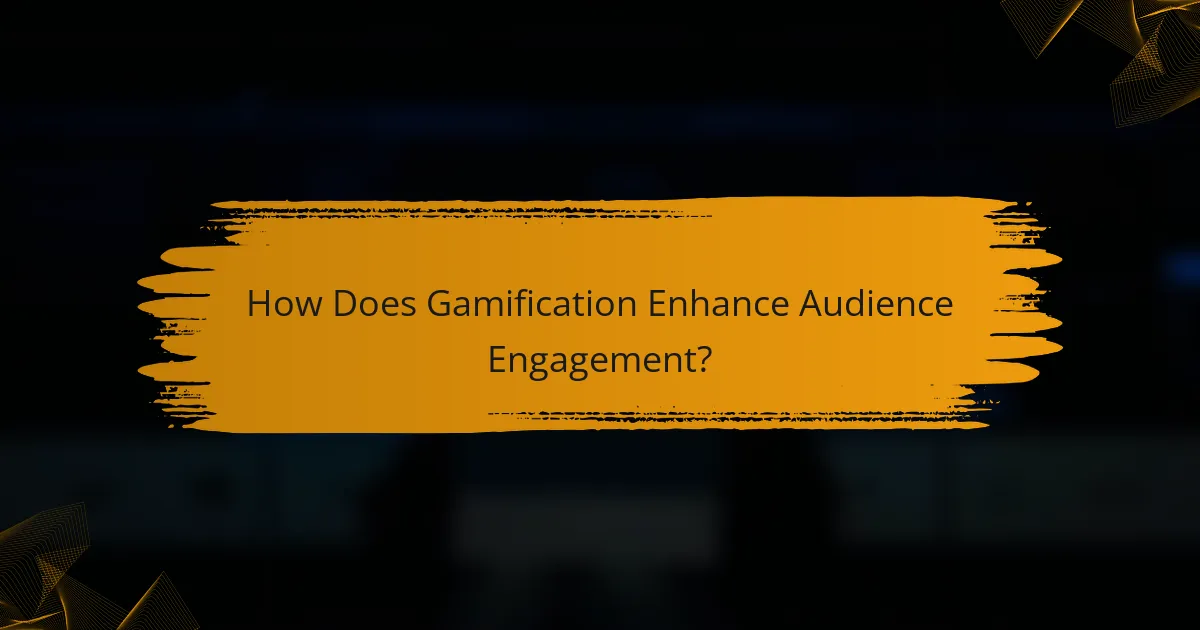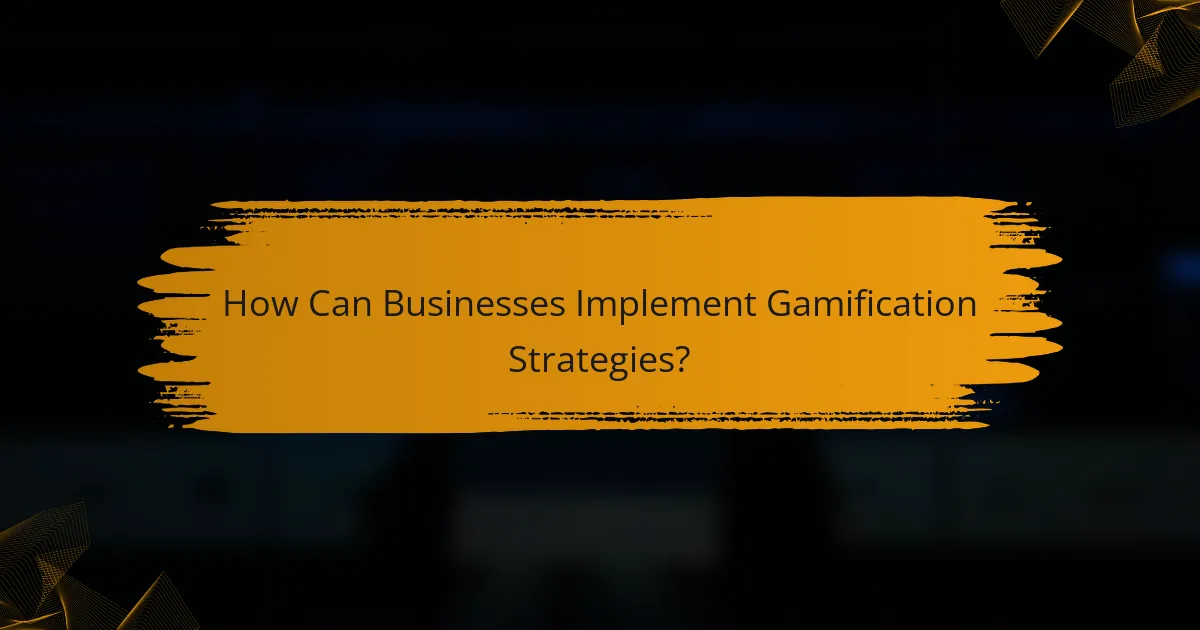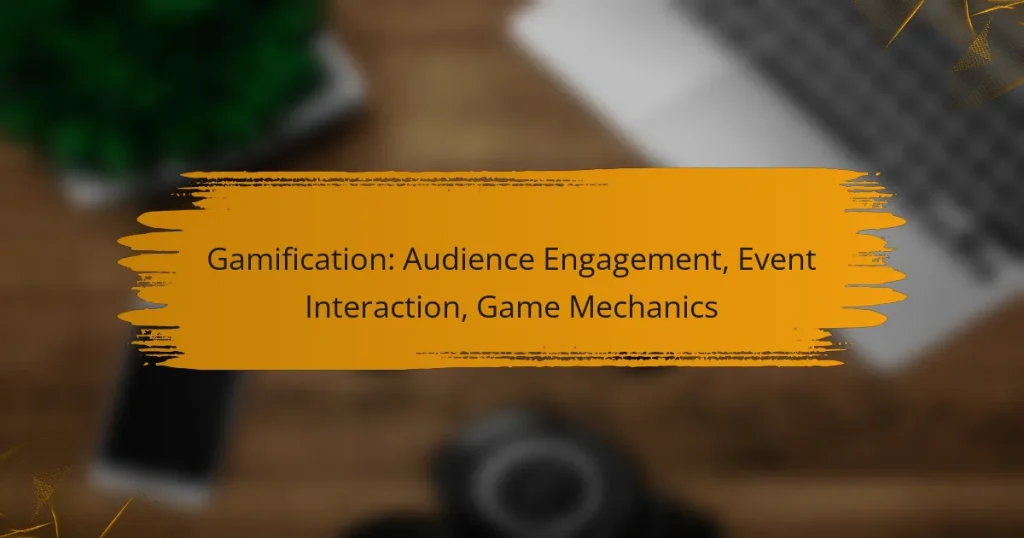Gamification transforms audience engagement by integrating game-like elements into various contexts, making interactions more enjoyable and motivating. By utilizing competition, rewards, and challenges, it captures attention and encourages active participation, particularly in event settings. Implementing effective game mechanics can enhance participant interaction, foster community, and create memorable experiences.

How Does Gamification Enhance Audience Engagement?
Gamification enhances audience engagement by incorporating game-like elements into non-game contexts, making interactions more enjoyable and motivating. This approach leverages competition, rewards, and challenges to capture attention and encourage active participation.
Increases motivation
Gamification increases motivation by tapping into intrinsic and extrinsic rewards. When participants earn points, badges, or levels, they feel a sense of accomplishment that drives them to engage more deeply with the content or activity.
For example, a loyalty program that rewards customers with points for purchases can motivate them to shop more frequently. Setting achievable goals and milestones can further enhance this motivation by providing clear targets to strive for.
Boosts participation
Gamification boosts participation by making activities more engaging and fun. When users are presented with challenges or competitions, they are more likely to join in and contribute actively.
Consider a conference that incorporates a mobile app with gamified elements, such as quizzes or scavenger hunts. Attendees are likely to participate more fully, as these elements create a dynamic and interactive experience.
Enhances retention
Gamification enhances retention by reinforcing learning and engagement through repeated interactions. When users engage with gamified content, they are more likely to remember information due to the enjoyable and interactive nature of the experience.
For instance, educational platforms that use game mechanics, like progress tracking and rewards for completing modules, can significantly improve knowledge retention among learners, making the learning process more effective.
Encourages social interaction
Gamification encourages social interaction by fostering a sense of community among participants. Leaderboards, team challenges, and collaborative tasks create opportunities for users to connect and engage with one another.
In a workplace setting, gamified team-building activities can enhance collaboration and communication, as employees work together to achieve common goals, strengthening their relationships in the process.
Provides instant feedback
Gamification provides instant feedback, allowing participants to see the results of their actions immediately. This timely feedback loop helps users understand their progress and areas for improvement.
For example, in an online learning environment, instant feedback on quizzes or interactive exercises can guide learners in real-time, helping them adjust their strategies and enhance their overall performance.

What Are Effective Game Mechanics for Events?
Effective game mechanics for events are strategies that enhance participant engagement and interaction through structured gameplay elements. These mechanics can motivate attendees, create a sense of competition, and foster community, making events more memorable and enjoyable.
Points and rewards systems
Points and rewards systems incentivize participation by allowing attendees to earn points for various actions, such as attending sessions or interacting with exhibitors. These points can be redeemed for prizes, discounts, or exclusive experiences, encouraging ongoing engagement throughout the event.
When designing a points system, consider the balance between effort and reward. For example, awarding 10 points for attending a session and 50 points for completing a survey can motivate attendees to engage more deeply. Ensure that rewards are desirable and attainable to maintain interest.
Leaderboards
Leaderboards create a competitive environment by displaying participants’ rankings based on their points or achievements. This visibility can drive engagement as attendees strive to improve their standings and earn recognition among peers.
To implement an effective leaderboard, update it regularly and display it prominently during the event. Consider using digital screens or mobile apps to keep the competition lively. However, be mindful of the competitive spirit; ensure that the environment remains friendly and inclusive.
Challenges and quests
Challenges and quests are specific tasks or missions that attendees can complete for points or rewards. These can range from simple activities, like visiting certain booths, to more complex tasks, such as solving puzzles or participating in workshops.
Design challenges that align with the event’s theme and goals. For example, a tech conference might include coding challenges or product demos. Clearly communicate the objectives and provide a timeline to encourage participation without overwhelming attendees.
Progress tracking
Progress tracking allows participants to monitor their achievements and see how close they are to completing challenges or earning rewards. This feature enhances motivation by providing a visual representation of their engagement level.
Utilize mobile apps or online dashboards to facilitate progress tracking. Make sure that updates are frequent and easy to access. Consider sending reminders or notifications to encourage participants to complete tasks and stay engaged throughout the event.

How Can Businesses Implement Gamification Strategies?
Businesses can implement gamification strategies by incorporating game-like elements into their processes to enhance audience engagement and interaction. This approach involves setting clear goals, selecting the right platforms, integrating with existing systems, and measuring success effectively.
Define clear objectives
Establishing clear objectives is crucial for effective gamification. Objectives should align with business goals, such as increasing user engagement, improving customer loyalty, or enhancing training outcomes. For example, a company might aim to boost sales by 20% through a rewards program.
Consider using the SMART criteria—Specific, Measurable, Achievable, Relevant, Time-bound—to ensure that goals are well-defined. This clarity helps in designing game mechanics that resonate with the target audience.
Choose appropriate platforms
Selecting the right platforms for gamification is essential for reaching your audience effectively. Consider where your audience spends most of their time, whether it’s mobile apps, websites, or social media. For instance, a retail brand might implement gamification on its mobile app to drive in-store purchases.
Evaluate the technical capabilities of each platform to support gamified elements, such as leaderboards, badges, or rewards systems. Ensure that the chosen platform can seamlessly integrate these features without compromising user experience.
Integrate with existing systems
Integration with existing systems is vital for a smooth implementation of gamification strategies. This may involve linking gamified elements with customer relationship management (CRM) systems, e-commerce platforms, or learning management systems. For example, an online education provider could integrate gamification into its LMS to enhance student engagement.
Ensure that the integration process is user-friendly and does not disrupt current workflows. Testing the system before full deployment can help identify potential issues and improve user experience.
Measure success metrics
Measuring success metrics is essential to evaluate the effectiveness of gamification strategies. Key performance indicators (KPIs) may include user engagement rates, completion rates, and overall satisfaction scores. For instance, tracking the number of users who participate in a gamified loyalty program can provide insights into its impact.
Utilize analytics tools to gather data on user behavior and outcomes. Regularly review these metrics to adjust strategies and improve engagement over time. Setting benchmarks based on industry standards can also help in assessing performance effectively.

What Are the Benefits of Gamification in Marketing?
Gamification in marketing offers several advantages, including increased engagement, improved customer loyalty, and enhanced user experiences. By integrating game mechanics into marketing strategies, brands can create interactive and enjoyable experiences that resonate with their audience.
Increases brand loyalty
Gamification fosters brand loyalty by creating a sense of community and belonging among customers. When consumers participate in engaging activities, such as loyalty programs or challenges, they are more likely to develop a stronger emotional connection to the brand.
For example, brands that implement point systems or rewards for repeat purchases can see a significant increase in customer retention. Offering exclusive rewards or experiences can further incentivize customers to remain loyal.
Enhances customer experience
By incorporating gamification elements, businesses can significantly enhance the customer experience. Interactive features, such as quizzes, leaderboards, and challenges, make the shopping process more enjoyable and memorable.
Consider using gamified elements like virtual try-ons or interactive product demos. These features not only engage customers but also help them make informed purchasing decisions, leading to higher satisfaction rates.
Drives lead generation
Gamification can effectively drive lead generation by encouraging users to share their experiences and invite others to participate. Engaging games or contests can motivate users to provide their contact information in exchange for rewards or entry into a prize draw.
For instance, a brand might host a social media challenge where participants share their experiences using a specific hashtag. This not only generates leads but also increases brand visibility and reach.

What Tools Are Available for Gamification?
Various tools are available for gamification, each designed to enhance audience engagement and interaction through game mechanics. These platforms offer features like rewards, leaderboards, and challenges to motivate users and increase participation.
Badgeville
Badgeville is a gamification platform that allows businesses to create custom reward systems to enhance user engagement. It offers features such as badges, leaderboards, and social sharing options, which can be tailored to fit specific organizational goals.
When using Badgeville, consider integrating it with existing systems to track user behavior effectively. This tool is particularly beneficial for companies looking to increase customer loyalty or employee performance through recognition and rewards.
Bunchball
Bunchball provides a comprehensive gamification solution that focuses on driving user engagement through game mechanics. It includes features like points, badges, and challenges, which can be implemented across various platforms, including websites and mobile apps.
One key aspect of Bunchball is its analytics capabilities, allowing organizations to measure the impact of gamification on user behavior. This data can help refine strategies and improve user experiences over time.
Gamify
Gamify is a user-friendly platform that enables businesses to create engaging experiences through gamification without extensive technical knowledge. It offers customizable templates and tools for adding game elements like quizzes, contests, and rewards.
For effective use of Gamify, focus on clear objectives and user feedback to enhance the gamified experience. This platform is ideal for marketers and educators looking to boost engagement and retention rates through interactive content.


